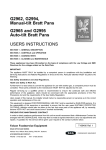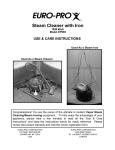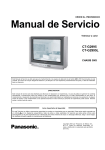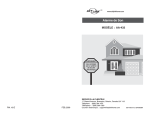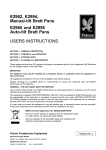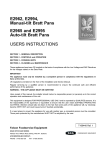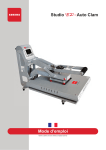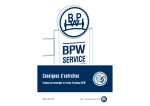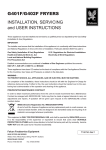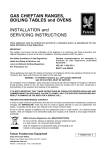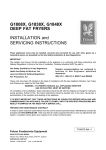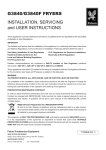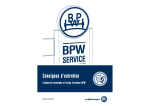Download G2962, G2994, Manual-tilt Bratt Pans G2965 and G2995 Auto
Transcript
G2962, G2994, Manual-tilt Bratt Pans G2965 and G2995 Auto-tilt Bratt Pans INSTALLATION and SERVICING INSTRUCTIONS These appliances must be installed and serviced by a qualified person as stipulated by the Gas Safety (Installation & Use) Regulations. IMPORTANT The installer must ensure that the installation of the appliance is in conformity with these instructions and National Regulations in force at the time of installation. Particular attention MUST be paid to - I.E.E Regulations for Electrical Installations Electricity At Work Regulations Gas Safety (Installation & Use) Regulations Health And Safety At Work etc. Act Local and National Building Regulations Fire Precautions Act Detailed recommendations are contained in Institute of Gas Engineers published documents : IGE/ UP/ 1, IGE/ UP/ 2 BS6173 and BS5440 These appliances have been CE-marked on the basis of compliance with the Gas Appliance Directive, EMC and Low Voltage Directive for the Countries, Gas Types and Pressures as stated on the data plate. WARNING - TO PREVENT SHOCKS, ALL APPLIANCES WHETHER GAS OR ELECTRIC MUST BE EARTHED. On completion of the installation, these instructions should be left with the Engineer-in-Charge for reference during servicing. Further to this, The Users Instructions should be handed over to the User, having had a demonstration of the operation and cleaning of the appliance. IT IS MOST IMPORTANT THAT THESE INSTRUCTIONS BE CONSULTED BEFORE INSTALLING AND COMMISSIONING THIS APPLIANCE. FAILURE TO COMPLY WITH THE SPECIFIED PROCEDURES MAY RESULT IN DAMAGE OR THE NEED FOR A SERVICE CALL. PREVENTATIVE MAINTENANCE CONTRACT In order to obtain maximum performance from this unit we would recommend that a maintenance contract be arranged with SERVICELINE. Visits may then be made at agreed intervals to carry out adjustments and repairs. A quotation for this service will be given upon request to the contact numbers below. WEEE Directive Registration No. WEE/DC0059TT/PRO At end of unit life, dispose of appliance and any replacement parts in a safe manner, via a licenced waste handler. Units are designed to be dismantled easily and recycling of all material is encouraged whenever practicable. Falcon Foodservice Equipment HEAD OFFICE AND WORKS Wallace View, Hillfoots Road, Stirling. FK9 5PY. Scotland. SERVICELINE CONTACT PHONE - 01438 363 000 FAX - 01438 369 900 T100723 Ref. 2 Warranty Policy Shortlist Warranty does not cover :Correcting faults caused by incorrect installation of a product. Where an engineer cannot gain access to a site or a product. Repeat commission visits. Replacement of any parts where damage has been caused by misuse. Engineer waiting time will be chargeable. Routine maintenance and cleaning. Gas conversions i.e. Natural to Propane gas. Descaling of water products and cleaning of water sensors where softeners/conditioners are not fitted, or are fitted and not maintained. Blocked drains. Independent steam generation systems. Gas, water and electrical supply external to unit. Light bulbs. Re-installing vacuum in kettle jackets. Replacement of grill burner ceramics when damage has been clearly caused by misuse. Where an engineer finds no fault with a product that has been reported faulty. Re-setting or adjustment of thermostats when unit is operating to specification. Cleaning and unblocking of fryer filter systems due to customer misuse. Lubrication and adjustment of door catches. Cleaning and Maintenance Cleaning of burner jets Poor combustion caused by lack of cleaning Lubrication of moving parts Lubrication of gas cocks Cleaning/adjustment of pilots Correction of gas pressure to appliance. Renewing of electric cable ends. Replacement of fuses Corrosion caused by use of chemical cleaners. SECTION 1 - INSTALLATION UNLESS OTHERWISE STATED, PARTS WHICH HAVE BEEN PROTECTED BY THE MANUFACTURER ARE NOT TO BE ADJUSTED BY THE INSTALLER. 1.4 GAS SUPPLY 1.1 MODEL NUMBERS, NETT WEIGHTS and DIMENSIONS MODEL G2962 G2965 G2994 G2995 WIDTH mm DEPTH mm HEIGHT mm WEIGHT kg WEIGHT lbs 600 600 900 900 770 770 770 770 870 870 870 870 120 120 165 165 265 265 364 364 1.2 SITING The unit should be installed on a level, fireproof surface, in a well lit and draught free position within a suitably ventilated room. If floor is constructed of combustible material then local fire requirements should be checked to ensure compliance. A clear space of 150mm should be left between unit rear and any combustible wall. A minimum vertical clearance of 900mm above top edge of appliance is required. Important The incoming service must be of sufficient size to supply full rate without excessive pressure drop. The gas meter should be checked, preferably by the gas supplier to ensure meter is adequate to deal with rate of gas supply required for the unit in addition to any other gas equipment installed. Installation pipes should be fitted in accordance with IGE/UP/2. The size of pipework from meter to unit must be not less than unit inlet connection Rp1/2 (1/2" BSP female). An isolating cock that is easily accessible to user, must be located close to unit to allow shut down during any emergency or routine servicing. The installation must be tested for gas tightness. Details are given in IGE/UP/1. The gas supply tubing or hose must comply with national requirements in force and require to be periodically examined and replaced as necessary. 1.5 ELECTRICAL SUPPLY If unit is to be installed in a suite formation with matching units then instructions for all models should be consulted in order to determine necessary clearances to any combustible rear wall or overlying surface(s). Some units require greater clearances than others. The largest figure quoted in the individual instructions will therefore determine clearance of the complete suite adjoining appliances. Flue discharges vertically along top rear of unit THERE MUST BE NO DIRECT CONNECTION OF THE FLUE TO THE OUTSIDE AIR OR TO A MECHANICAL EXTRACTION SYSTEM. See Section 1.3 for ventilation details. After appliance position has been established, it is recommended that the feet (on a unit fitted with feet) be secured to floor using holes provided. These appliances are designed for operation on a 230V 50Hz 3A electrical supply. As mains lead wire colours may not correspond with the markings which identify plug terminals, proceed as follows: The wire coloured GREEN and YELLOW must be connected to plug terminal which is marked with the letter E or the earth symbol or coloured GREEN or GREEN and YELLOW. The wire coloured BLUE must be connected to terminal marked with letter N or coloured BLACK. The wire coloured BROWN must be connected to terminal marked with letter L or coloured RED. 1.3 VENTILATION 1.7 TOTAL RATED HEAT INPUTS NATURAL and PROPANE GAS Sufficient ventilation, natural or mechanical, must be provided to supply adequate fresh air for proper combustion. It should also prevent occurrence of unacceptable concentrations of substances harmful to health in the location where equipment is installed. It is also required to be able to remove any such products that may occur, safely and efficiently. Recommendations for Ventilation of Catering Appliances are provided in BS5440 : 2. For multiple installations, requirements for individual appliances should be added together. Installation should be made in accordance with local and/or national regulations which apply at the time. A qualified installer MUST be employed. 1.6 WATER SUPPLY Not applicable to these appliances. Model G2962/2965 G2994/2995 kW (nett) 10.2 15.9 Btu/hr (gross) 38,300 59,700 1.8 INJECTOR SIZES NATURAL and PROPANE GAS G2962/2965 MAIN BURNER RH MAIN BURNER LH PILOT BURNER CROSS-LIGHTING BURNER G2994/2995 MAIN BURNER RH MAIN BURNER CENTRE MAIN BURNER LH PILOT BURNER CROSS-LIGHTING BURNER - LH CROSS LIGHTING BURNER - RH NATURAL PROPANE Amal 470 Amal 400 SIT No. 36 Amal 75 Amal 180 Amal 140 SIT No.19 Amal 20 NATURAL PROPANE Amal 490 Amal 400 Amal 430 SIT No. 36 Amal 75 Amal 85 Amal 190 Amal 190 Amal 190 SIT No. 19 Amal 20 Amal 20 2.1 ASSEMBLY Position unit and level by adjusting leg levelling feet or castors as appropriate. Each foot (on units with feet) contains a hole to enable floor fixing to be made. 2.1.1 Units on Castors Refer to addendum T100286 supplied. In addition, drain pan contents before attempting to move unit. Also, lower pan prior to moving. 2.2 CONNECTION TO THE GAS SUPPLY Inlet connection terminates at bottom RH corner when viewed from rear and is Rp1/2 (1/2" BSP Female). Test for gas tightness. The integral gas supply, downstream of gas valve, may be checked by applying leak detection spray with burner lit. 2.3 CONNECTION TO ELECTRICITY SUPPLY 1.9 GAS PRESSURE The unit operates at the following pressures - Operating Pressure SECTION 2 - ASSEMBLY and COMMISSIONING Supply Pressure NATURAL PROPANE NATURAL PROPANE 15 mbar 37 mbar 20 mbar 37 mbar 6 in. w.g. 14.8 in. w.g. 8 in. w.g. 14.8 in. w.g. Ignition Pressure NATURAL PROPANE 5 mbar 17.5 mbar 2 in. w.g. 7 in. w.g. Ignition and operating pressures are measured at oulet test point located on front face of multi-functional control - see Figure 1 (Servicing Section 3.8) 1.10 BURNER ADJUSTMENT The only adjustment necessary on main burner is the correct setting of gas pressures as described in Section 1.9. No aeration adjustment is provided. Pilot flame should envelop approximately 6mm to 10mm of thermocouple tip. If any adjustment is required, unit must be serviced. Make electrical connection. Unit is designed for connection to a 230V AC supply. A 2 metre long mains lead is fitted as standard. Mains lead wires are coloured in accordance with the following code: Green and Yellow Blue Brown Earth Neutral Live The wires should be connected to plug as follows: EARTH to terminal marked E, or coloured GREEN. NEUTRAL to terminal marked N or coloured BLACK. LIVE to terminal marked L, or coloured RED. Unit must be protected by 3 amp fuse if 13 amp (BS1363) plug is used. Any other type of connection must be protected by 5 amp fuse at distribution board. Warning THIS APPLIANCE MUST BE EARTHED. 2.4 CONNECTION TO THE WATER SUPPLY Not applicable to this appliance. 2.5 PRE-COMMISSIONING CHECK Important After installation, the engineer should check that all gas connections are tight and do not leak. Also check that all electrical connections are secure. The installation engineer should check that unit is operating satisfactorily before leaving kitchen. Particular attention should be given to pressure settings detailed in Section 1.9 and pilot adjustment as detailed in Section 1.10. 2.6 INSTRUCTION TO USER After installing and commissioning appliance, please hand User Instructions to user or purchaser and ensure that person(s) responsible understand the instructions and procedures for lighting, cleaning and correct use of appliance. It is important to ensure that locations of gas isolating cock and electrical socket or switch are made known to user and procedures for operating these in an emergency be demonstrated. SECTION 3 - SERVICING and CONVERSION Important BEFORE ATTEMPTING ANY SERVICING, SWITCH APPLIANCE OFF AT MAIN GAS AND ELECTRICITY SUPPLY ISOLATORS. CARE MUST BE TAKEN TO ENSURE THESE ARE NOT INADVERTENTLY SWITCHED ON DURING TASK. Certain operations require pan to be tilted or the activator repositioned with control panel removed. If this is done electrically, care should be taken not to touch any live terminals and that control panel is supported adequately so that none of the live switch parts or thermostat terminal can touch earthed parts. General Note AFTER ANY MAINTENANCE TASK, CHECK APPLIANCE TO ENSURE IT PERFORMS CORRECTLY. CARRY OUT ANY NECESSARY ADJUSTMENTS AS DETAILED IN THE APPROPRIATE SECTION OF THIS DOCUMENT. After carrying out any servicing or exchange of gas components - ALWAYS CHECK FOR GAS TIGHTNESS 3.1 CONVERSION When changing from one gas family to another always ensure the following Change main, pilot and cross-lighting burner injectors. Refer to Section 1.8. Injectors must be re-sealed using thread sealant. Set pressures (REG ADJ, 1 STEP ADJ & NO PR). Refer to Section 3.8. Adjust pilot flame length. Refer to Section 1.10. Change data plate. For detailed procedure, refer to appropriate section in this document. 3.2 REMOVAL OF CONTROL PANELS Main Panel Ensure pan is in DOWN position. Pull off thermostat control knob. On G2962 and G2994 models, remove handwheel by undoing central fixing. Open drop down door. Remove fixings at corners of control panel bottom edge and also those in top flange. Pull panel clear of appliance and carefully rest it on floor. Take care not to strain wiring. Replace in reverse order. Lower Inner Panel Remove main panel before removing fixings for lower panel and pull clear. 3.3 BURNERS Removal Of Main Burners Tilt pan to full position to allow access to burner compartment. Remove fixings that retain burners to base of compartment. Slide burner from injector and remove. Replace in reverse order. 3.4 INJECTORS 3.4.1 Removal Of Main Burner Injectors Remove main burners as detailed in Section 3.3. Undo injectors or injector jets as required. Replace in reverse order taking care that correct injector is fitted to each burner. Injectors must be re-sealed using thread sealant. 3.4.2 Removal Of Cross Lighting Burner Remove main control panel. (See Section 3.2) Tilt pan to fully raised position. On G2962/G2994 models, temporarily re-fit handle upon shaft. On G2965/G2995, drop-down door must be closed to operate foot bellows. Undo compression fitting nut at cross-lighting burner base. From top, remove fixings that secure cross-lighting burner and remove burner by lifting it up. Replace in reverse order. 3.4.3 Removal Of Cross Lighting Injector The complete burner can be removed as detailed in Section 3.4.2. Alternatively, injector can be removed leaving burner in position. To achieve this, remove control panel, undo compression fitting nut and remove fitting from burner venturi tube. Injector can now be removed for renewal or cleaning. When re-assembling, the injector must be re-sealed using thread sealant. 3.4.4 Removal Of Pilot Burner Assembly Remove both control panels and fully raise pan (see Section 3.2). On G2962/G2994 models, temporarily replace tilting handle and fully raise pan. On G2965 and G2995, drop down door must be closed to operate foot bellows. Undo fixings that secure pilot assembly to base of burner compartment. In controls compartment, pull off electrode lead connector at spark igniter and undo thermocouple and pilot supply pipe connections at rear of multi-functional control. Remove assembly complete with pilot supply pipe by pulling up and away from base of burner compartment. Replace in reverse order, ensuring thermocouple end is clean (do not use thread compound) and do not over tighten. Ensure pilot supply pipe is correctly fitted and check for leaks using soapy water. Adjust pilot to achieve flame as detailed in Section 1.10. This is achieved by turning pilot adjusting screw (see Figure 1) clockwise to reduce and vice versa. After making any adjustment, ensure cross-lighting burner ignites quickly from pilot. 3.5 REMOVAL OF THERMOCOUPLE Remove main control panel. Remove main burners as detailed in Section 3.3. Undo thermocouple connection at pilot and multifunctional control valve and remove. Replace in reverse order ensuring thermocouple is pushed fully into pilot bracket before tightening connection. 3.6 PIEZO IGNITER/ SPARK IGNITER 3.6.1 Removal Of Spark Electrode Follow procedure detailed in Section 3.5. Undo connection to pilot burner to remove electrode. Undo lead connection to electrode. Replace in reverse order ensuring connection to pilot assembly is not overtight as to crack electrode. 3.6.2 Piezo Unit The igniter is a Piezo spark type and contains no battery. The unit is located on LH side of gas control unit mounting bracket secured by two fixings. A faulty unit cannot be serviced and must be replaced. 3.7 THERMOSTAT 3.7.1 Control Thermostat To Remove a) Remove main control panel as Section 3.2. b) Raise pan fully. c) Remove phial clamping plates on pan underside. d) Pull off connections, noting their locations. e) Remove fixings that secure thermostat to bracket. f) Remove thermostat, threading capillary tube and phial through apertures. g) Replace in reverse order. Ensure capillary bulb and sleeving are in identical position to that of original component. 3.7.2 High Temperature Limit Device The device is set to trip when centre oil temperature at a maximum depth of 50mm reaches 225oC. It should not be interfered with unless cut-out has occurred and device requires to be re-set. To Re-set a) Remove main control panel (as Section 3.2). b) Press centre spindle pin in until a click occurs. c) Replace control panel. To Replace a) Carry out operations (a) and (b) (as Section 3.7.1). b) Remove phial clamp from pan underside. c) Pull off connections, noting respective locations. d) Remove fixing that securs thermostat body to bracket. e) Remove thermostat, threading capillary tube and phial through apertures. f) Replace in reverse order. Ensure capillary bulb and sleeving are in identical position to that of original component. 1. To Check Operation Operation of high temperature limit device must be checked at regular intervals adopting following procedure: a) Remove main control panel as Section 3.2. b) Refer to wiring diagram. Bypass user thermostat by supplying power directly to gas control valve from live connection of main terminal block. c) Fill pan with oil to recommended depth of 50mm for deep frying and install a means of measuring oil temperature. Measuring sensor must be placed at geometric pan centre and 25mm below oil surface. d) Light unit and observe rising oil temperature. If functioning properly, limit device will cut off power when oil temperature is between 220oC and 225oC (maximum). If device fails to operate at maximum temperature of 230oC, shut off unit immediately by pressing OFF button on gas control valve and carry out investigations to find the fault. e) When limit device is functioning correctly, reconnect user thermostat and when oil cools sufficiently, re-set limit device. f) Ensure user thermost operates correctly. Warning: Never leave a unit with users thermostat bypassed. 3.8 GAS CONTROL UNIT (MULTIFUNCTIONAL CONTROL) The gas control unit combines gas governor, flame failure safety device and push buttons for start and shut down. Before removing, ensure main gas and electricity supplies are shut off. To Remove Gas Control Unit Remove control panels as detailed in Section 3.2. Remove terminal cover from control unit and remove terminal wires. Undo compression-fitting nut on gas inlet pipe at control unit. Undo compression fitting nut on burner gas pipe at the rear of solenoid valve. Disconnect supply wires to solenoid valve, first remove tape that binds cables together. (It is not possible to remove connections at solenoid itself). Disconnect pilot supply pipe and thermocouple at rear of control unit. Pull off wire from spark igniter. From below base, undo fixings that secure control unit mounting bracket. Remove unit complete with spark igniter, solenoid valve and bracket. Disconnect spark igniter, solenoid valve and mounting bracket from existing control unit and re-fit to eplacement. Re-fit new assembly and replace in reverse order. 2. 3. 5. 6. 11. 7. 10. 12. 9. 1. Inlet pressure test point 2. Pilot Adj. 3. 1st Step Adj. 4. Pilot Button 5. Reg. Adj. 6. Outlet pressure test point Figure 1 8. 4. 7. No PR 8. Off Button 9. Thermocouple Connection (below) 10. Main Burner Button 11. Pilot Connection (below) 12. Piezo igniter button To Adjust Gas Pressure (Natural Gas Appliances Only) Refer to Figure 1. Remove screw from outlet test point and connect gauge. Remove protective cap marked NO PR and ensure the screw below is turned fully clockwise. (Unless this is done, the governor section of control is rendered inoperative). Then proceed as follows: a) Light burner and turn 1 STEP ADJ screw fully clockwise. b) Remove plastic cap from REG ADJ screw. Turn screw to adjust outlet pressure as necessary. (Clockwise to increase and vice-versa) c) Turn 1 STEP ADJ screw anticlockwise by no more than an eighth of a turn. If necessary re-adjust REG ADJ screw to restore correct pressure. d) Extinguish burner by turning thermostat control knob OFF. e) Re-light burner by turning thermostat knob to '5' while observing pressure gauge. Pressure should initially be approx. 5 mbar, pausing for a brief period at this pressure before rising to full desired burner pressure of 15 mbar. f) If when performing operation (e), pressure is less than 5 mbar, open 1 STEP ADJ screw a further eighth turn and re-adjust the REG ADJ screw as necessary to restore correct burner pressure. Repeat operations from (d). g) When satisfied that burner pressure is correct and two-stage ignition pressure facility produces smooth lighting of burner, turn gas off and replace pressure test point screw and protective caps. To Adjust Gas Pressure (Propane Appliances Only) Instructions for setting STEP OPENING facility on ELECTROSIT gas control valve (Refer to Figure 1). 1. Remove outlet pressure test point screw and fit pressure gauge. 2. After removing protective cap, turn NO PR screw fully anti-clockwise. 3. After removing protective cap, turn 1 STEP ADJ screw fully clockwise. 4. Light pilot and push main burner button to the right. 5. Open 1 STEP ADJ screw very slightly (approx. an eighth of a turn). 6. Light burner by turning thermostat control to '5' and observe pressure gauge. Pressure should initially be 17.5 mbar then pause briefly before rising to full outlet pressure. If 17.5 mbar is not initially registered then turn thermostat knob to "OFF" and repeat from Step 5. Note It must be emphasised that the 1 STEP ADJ screw must be turned by very small increments only, NEVER more than an eighth turn at any one time. 7. When satisfied that burner lights smoothly and progressively from STEP OPENING facility, remove pressure gauge, fit screw and refit plastic protective covers. 3.9 GOVERNOR The governor is incorporated in the multi-functional control. See Section 3.8 to remove and adjust. 3.10 CHECKING and SERVICING THE GAS CONTROL UNIT Pilot Will NOT Light a) Main gas supply must be turned on and pilot gas supply line purged of air. b) Press start button, apply a light to pilot and hold in for approximately 30 seconds. c) If pilot will not light after above procedure, there is a possible obstruction to gas flow. This could be a clogged pilot or tubing orifice. Alternatively, pilot gas adjustment screw may be closed. The pilot flame should envelop 6 to 10mm of thermocouple tip. Remove pilot adjustment screw cap, turn inner adjustment screw clockwise to decrease, or anti- clockwise to increase pilot flame. Replace cap screw. Pilot Goes OUT When Start Button is Released a) Check pilot flame adjustment as above. b) Check that thermocouple to control unit connection is clean and secure. c) If power unit does not hold, replace thermocouple. If this does not correct condition, replace control unit. Checkout Put lighting sequence into operation and observe, through a complete cycle that main burner functions properly. To Light The Burners a) Switch off electricity supply to pan and turn thermostat control OFF. b) Press and hold pilot button in fully while repeatedly pressing and releasing igniter button until pilot lights, observe through sight-hole. c) Keep pilot button pushed in fully for 20 seconds then release it. Pilot should remain alight but should it go out, push in OFF button and wait 3 minutes before repeating from Step (b). d) With pan fully lowered, push main burner button to right. e) Turn electricity on and check red neon lights. Set thermostat control to desired setting and main burner will light. If Main Burner Does Not Light If burner does not light, high temperature limit device may have tripped. To re-set, refer to Section 3.7.2. Investigate reason for trip. To Shut Down For Short Periods Turn thermostat knob OFF. This leaves only pilot lit. For Longer Periods (Complete Shut-down) a) Turn thermostat knob to OFF. b) Push in gas control OFF button. c) Turn off electricity to appliance. Note Gas control is fitted with a safety interlock, therefore a period of 3 minutes will elapse before it is possible to re-light after complete shut-down. 3.11 GAS SOLENOID VALVE This is positioned between multifunctional control valve and main burner inlet. To Remove a) Remove control panel as detailed in Section 3.2. b) Disconnect wiring to solenoid valve. c) Remove multifunctional control valve complete with solenoid valve (as Section 3.8). Seperate. solenoid valve from assembly. d) Undo solenoid valve from multi-functional control. e) Replace or fit new valve in reverse order. f) To remove solenoid coil, disconnect wires and remove circlip from top of solenoid spindle. Pull coil free of centre spindle. 3.12 NEONS To replace a neon, first remove control panel (Refer to Section 3.2). Remove connections and undo nut that secures neon to panel and pull neon from panel front. Replace neon (230V type) and securing nut and replace electrical connections. 3.13 TILT SWITCH MECHANISM (G2962/2994 Models) This switch is located at base of screw jack. Access is gained by removing 2 fixings to enable removal of small rectangular inspection plate at bottom of outer back panel. To remove switch, proceed as follows a) Raise pan slightly so that end of the screw jack is at least 50mm away from tilt switch. b) Undo fixing securing switch bracket to lower bearing block. c) Remove switch and bracket assembly. Disconnect wires and note respective positions for correct replacement. d) Undo fixings which secure switch and tufnol insulation strip to bracket. e) When replacing switch/bracket assembly, tighten fixing until bracket is firm and allow adjustment by application of a small amount of force. Bracket should be positioned at lower end of possible adjustment at this stage. f) Lower pan to horizontal working position. Adjust switch to operating setting by pushing bracket upward until switch arm is engaged on bottom of jack. This will depress switch button. g) Fully tighten fixing which secures switch bracket. Operation of tilt switch mechanism must be checked at regular intervals. Procedure as follows a) Light burners as detailed in Section 2 of User Instruction manual. b) Slightly raise pan by turning screw jack handle. c) Look into burner chamber and observe that flames extinguish. This will indicate that tilt switch is cutting power supply to controls If burner does not go out then check operation of switch mechanism and replace if necessary. 3.14 TILT SWITCH MECHANISM (G2965/G2995 Models) To Remove a) Remove main control panel. b) Raise pan. c) Undo locknut at bottom of main rod. Undo and remove rod. d) Undo electrical connections. e) Remove fixings that secure mechanism to base angle. Remove mechanism. To Replace Replace in reverse order with main rod and adjusting screws fully home to prevent damage to switch when lowering pan prior to setting. To Set There are two ways to set switch: a) For coarse setting, use main rod. b) For fine and final setting, use screw that presses on microswitch lever. Switch should be set with pan fully lowered position. Adjust until switch closes. Check operation of tilt switch at regular intervals, adopt the following procedure:a) Light burners as detailed in User Manual. b) Raise pan slightly using tilt mechanism. c) Look into burner chamber and observe that flames extinguish. This will indicate that tilt switch is cutting off supply to controls. If burner does not go out, check operation switch mechanism, replacing it if necessary. 3.15 CHANGE OVER SWITCH (G2965/G2995) To Remove a) Remove main control panel. b) Remove electrical connections. c) Remove knob and undo nut holding switch. Replace in reverse order. 3.16 AIR SWITCHES (G2965/G2995) To Remove a) Remove control and inner panels as detailed in Section 3.2. b) Undo electrical and air connections. c) Undo fixings which retain switch bracket to base. d) Remove bracket fixings. It is important that any replacement switch be fitted with identical screws. Fixings of longer or larger diameter could damage the switch therefore, care should be taken to retain the original fixings unless direct replacements are available. Replace in reverse order paying attention to note (d) above. 3.17 DOOR SWITCH (G2965/G2995) To Remove a) Remove both panels. b) Disconnect electrical supply. c) Undo fixings. Replace in reverse order. 3.18 LINEAR POWER PACK (G2965/G2995) To Remove a) Remove both panels. b) Raise pan to approx. half way position and support. c) Remove top fulcrum pin. d) Lower actuator completely and ensure the pan is electrically isolated. e) Disconnect electric connection to the motor at the switches and terminals. f) Slacken fixings which retain the handle guide tube, twist the tube c.c.w and remove. Retighten fixings. g) Remove bottom fulcrum pin. h) Ease actuator out. j) Loosen grub screw and remove spindle adaptor. Replace in reverse order. 3.19 FOOT PADS (G2965/G2995) To Remove a) Remove main panel. b) Undo air pipes from air switches. c) Remove the split pin under the pan base which secures the foot pad arm to the swivel bracket. d) The arm can now be removed complete with air pipes. Air pipes can be fed through aluminium foot plate to give some slack. e) Turn pad (c.c. up pad) for about 20o until free of retaining ring. f) Pull tube through hinge tube and conduit. g) If necessary, undo fixings and remove retaining ring from platform. Replace in reverse order. Take care not to pinch air tubing and remember to replace washer below split pin inside the controls compartment. SECTION 4 - SPARE PARTS When ordering spare parts, always quote the appliance type and serial number. This information will be found on the data badge attached to the controls cover behind the controls compartment door. G2962 and G2994 BRATT PANS WIRING DIAGRAM 14 21 11 13 25 27 6 8 7 2 4 3 23 31 13 30 30 29 2 11 4 3 SOLENOID VALVE A2 A1 26 6 8 7 A2 A1 23 27 24 26 WIRING DIAGRAM 4 3 2 3 1 10 2 3 1 12 AIR SWITCH UP DOOR SWITCH 9 12 2 AIR SWITCH DOWN 24 3 1 10 25 G2965 and G2995 BRATT PANS 8 GAS VALVE 7 20 16 18 15 FUSE 5A ANTI SURGE RED INDICATOR 28 29 28 L1 1 15 18 5 31 N 16 AMBER INDICATOR 14 4 7 17 8 20 1 E 19 32 2 6 3 THERMOSTAT 22 22 P3 5 9 P1 1 P 3 6 P2 4 2 19 2 TILT SWITCH 1 3 1 2 LIMIT DEVICE 1 2 5 C/O SWITCH











